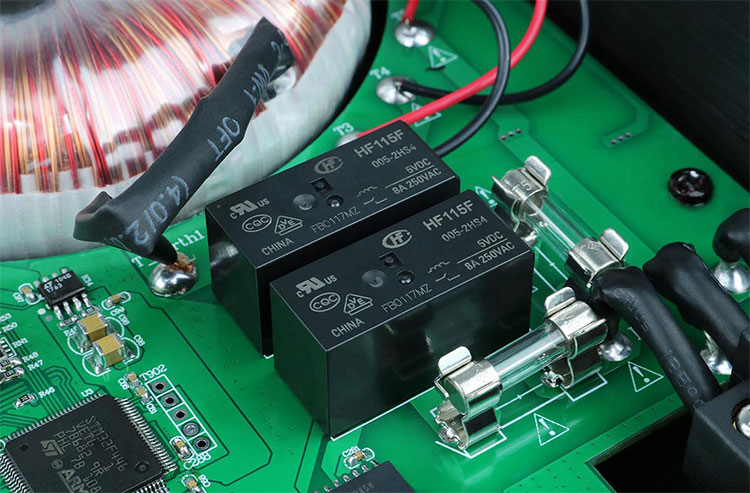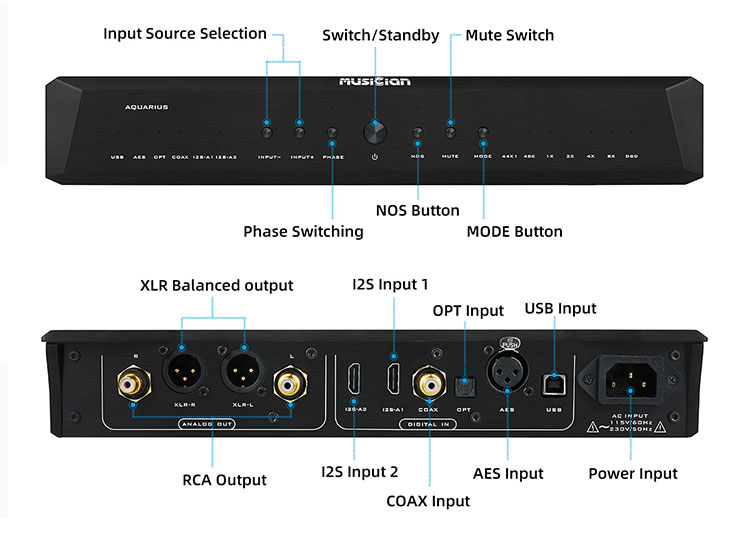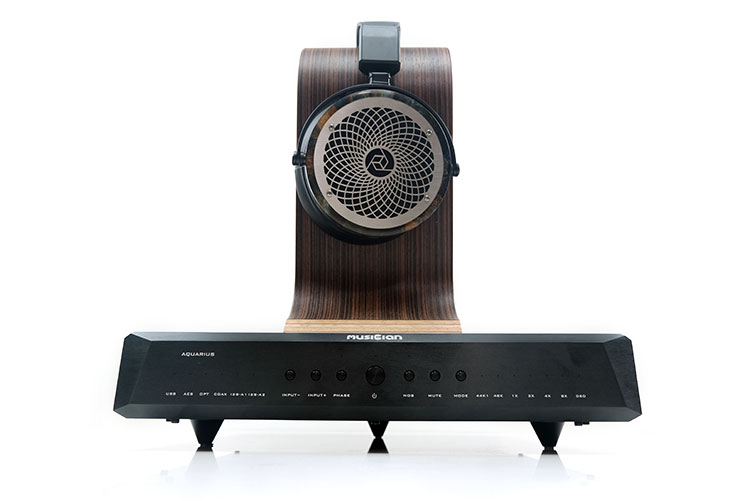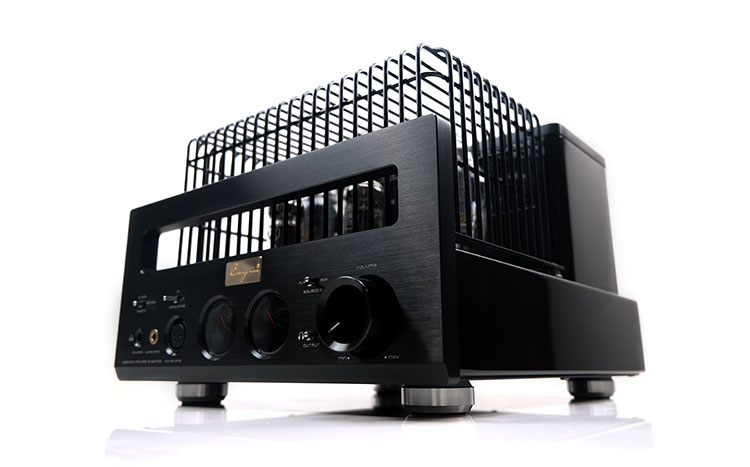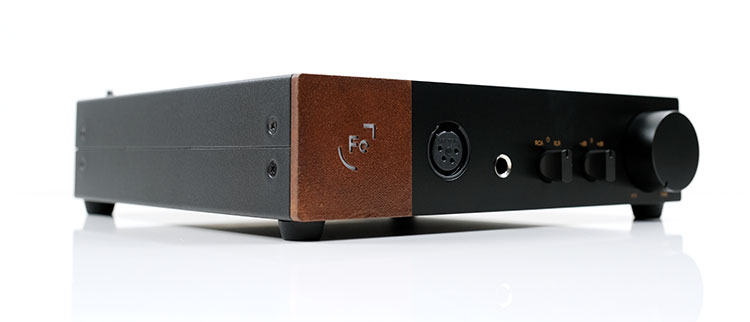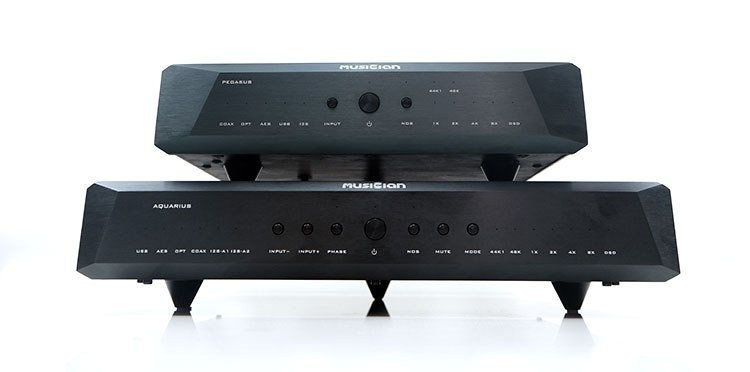Musician Audio Aquarius Review
This is a review of the new Musician Audio Aquarius which is a balanced high-end R-2R array desktop DAC with additional DSD architecture. It is priced at $3199.99.
Disclaimer: This is a sample sent to us in exchange for our honest opinion. Headfonics is an independent website with no affiliate links or status. We thank Musician Audio and Aoshida Audio for this opportunity.
To read more about Musician Audio gear that we have previously covered on Headfonics click here.
Note, that this article follows our latest scoring guidelines which you can read up on here.
The Musician Audio Pegasus was our surprise package from last year. A compact and not unreasonably priced desktop balanced R-2R DAC that scored really well and walked away with our Top Gear Award for 2021.
Taking on their new flagship Aquarius DAC in 2022 seems like the next logical albeit tasty step in our discovery of this relatively new audio brand.
I say flagship because since our review of the Musician Audio Pegasus has come out with a whole range of new desktop units ranging from dedicated DSD decoders, amplifiers, and even cheaper R-2R DACs such as the Draco.
At a shade over three grand, however, the Aquarius is way above everything else the company has to offer, putting the likes of the Hugo TT2 and Holo Audio’s R-2R DAC range firmly in their sights.
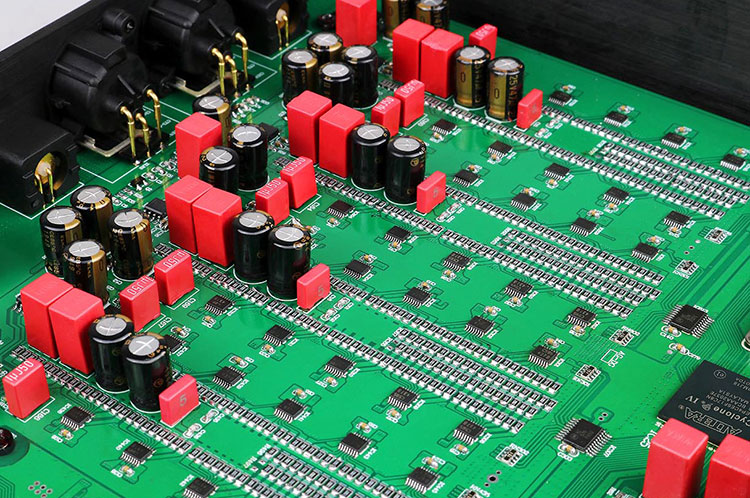
TECH HIGHLIGHTS
THE R-2R DIFFERENCE
For those new to the concept of R-2R, this is quite a different digital to analog conversion process compared to the modern delta-sigma DAC or some of the more proprietary FPGA-based solutions from the likes of Chord or dCS.
In some ways, it is one of the oldest but perhaps one of the most versatile DAC approaches still available with a strong emphasis on discrete topology designs and precisely matched resistors implemented by hand.
In essence, this gives the Musician Audio engineers 100% control over a very wide range of parameters for tuning the DAC’s decoding performance. It also usually brings in a distinct and more analog flavor to the DAC’s signature whereas the delta-sigma variants can often be accused of sounding more ‘digitally perfect’.
Contrast this with ‘off-the-shelf’ delta-sigma SoC, for example, which from an engineering angle is traditionally an all-in-one solution designed to take a lot of the legwork from a company’s R’n’D budget and reduce engineering costs.
Parameters for delta-sigma adjustment are usually more limited until you get to the analog side where opamps, rollable or otherwise, can take up the slack and introduce whatever flavor you like to the sound.
TOPOLOGY
The Aquarius is a pure desktop DAC with a balanced topology as well as single-ended analog output capability alongside a digital input array that is significantly more feature-packed than the Pegasus.
Internally, it consists of four ladder rails of discrete 24BIT resistors, or double that of the smaller Pegasus. Each one is handpicked to within 0.005% precision resistance for core R2R native 1BIT PCM decoding capability with an additional ladder for 6BIT DSD processing, (32 steps FIR Filters).
Behind each channel, the Aquarius also has a digital bridge managed by an FPGA-based Altera Cyclone IV combined with a double constant temperature Crystal oscillation implementation for DSP and jitter control.
The Aquarius’s power supply is an O-type toroidal transformer wound with single crystal copper wiring combined with linear regulators for AC conditioning on input and just after before it moves to the digital management and decoding.
DECODING
You will require a dedicated Thesycon software driver to get the best out of the Aquarius on Windows for decoding. However, its best far outshines a lot of the competition with rates of up to PCM 32BIT/1536kHz and DSD1024 via USB and I²S.
That’s a big jump from the usual top-tier of DSD512 and PCM 32BIT/768kHz though there is no MQA capability.
The reason behind those super high numbers is the use of a custom-designed USB solution tied to an STMicroelectronics ARM Cortex-M4-based STM32F446 processor as opposed to something more off-the-shelf such as XMOS.
It is not that different actually to how they approached the Pegasus setup which also boasts of similar numbers and uses the same chipset.
Every other Aquarius input is also pretty much maxed out to its designed capability so that means 24BIT/192k PCM and DSD64-DoP for its coaxial and optical inputs.
The one big difference this time from the Pegasus, however, is the Aquarius dual I²S setup is actually user-programmable to work with a very wide range of I²S sources. Something we try out in more detail on page 2 of this review.

DESIGN
The Pegasus design language remains strong with the Aquarius just that everything is now upsized making this a large desktop unit.
The color choices are somewhat similar to the Pegasus also with a dark and silvery-white alternative though the darker version of the Aquarius we have here has less of that green tint from the Pegasus finishing and more of a class shiny black hue.
The machining is unchanged which is good news as I kind of like how Musician Audio put together their units. There are no LCD panels, it’s all diodes and buttons on that cleverly angular brushed aluminum front plate. It exudes that classic HiFi look rather than the more modern information-intensive display styling of competing units.
The chassis paneling behind the front plate is also a robust aluminum alloy with discrete locking screws to the rear. The curving is not terribly sharp so there are no nasty surprises for your hands when lifting the unit.
The dimensions are 33*30*7.5cm which, like its smaller sibling makes this a fairly slim but wide form factor with an almost doubling of the weight to 5.6kg. It is still supported by that tripod rubbery feet system on the base, which, when left alone is very stable.
However, you do need to be careful about where you apply any pressure on the chassis as too much to the left or right can tip the unit to one side or the other. If you are going to stack make sure the unit above is well centered.
I/O
I²S MODES
You get an expanded I/O selection on the Aquarius compared to the Pegasus. This is primarily in the form of two I²S inputs as opposed to one which is just super for my Cayin iDAP-6 and something else like a CD transport.
It is not just the additional I²S port that should have enthusiasts licking their lips but also the pin mapping is not fixed either. I²S is not a fixed standard so even though it’s HDMI plug compatible the pin configs for a wide variety of sources or transports differ leaving a compatibility question.
Through the use of the mute and phase button combos on the front of the Aquarius, you have up to 8 different pin configuration modes that ideally should prove to be compatible with your I²S source device.
STANDARD LINEUP
Aside from that handy I²S I/O option, you get all the regular analog and digital alternatives that came with the Pegasus.
That includes SE dual RCA and balanced 3-pin XLR to the far left for your analog output and dual I²S, coaxial, optical, USB, and AES in the middle. To the far right, you get a multi-voltage 3-prong Furutech power socket connected to the linear regulators and the O-type toroidal transformer.
One thing I did note is the rated voltage output of the analog outs is on paper a little lower than the Pegasus at 3.59V for balanced XLR and 1.79V for SE when using the PCM ladders. When switching to the 6BIT DSD ladder it drops to 2.66V and 1.33V respectively.
Both outputs are a little on the low side for standard voltage ratings for DAC analog outputs but I suspect this is a correction from the original Pegasus performance, which I felt was lower than its rating given the high output impedance of 625Ω SE and 1250Ω balanced.
CONNECTION DESIGN TWEAK
There is one production run design change from the Pegasus sample we have here and that’s the overhang on the top panel at the rear of the main chassis which is now gone on the Aquarius. I believe that may well be the case also with recent Pegasus units also.
Now you have a flatter or slightly recessed top panel finish making access to I/O connections a lot easier than before. The older design’s overhang was right over the digital section which sometimes forced me to swivel the unit around head-on to correctly insert some cables.
CONTROLS
Sadly, still no remote control for this device which would have been appropriate given its flagship status. Instead, status is via a series of LED lights above each label via manual controls all of which are located on the front panel of the Aquarius. Couch potatoes take note.
The control suite is more complex and in-depth compared to the Pegasus with no less than 6 unique buttons compared to just two. Some of the controls are the same as the Pegasus with both having an input controller and a NOS button if, like me, you like to keep listening without oversampling.
However, this time you have additional mute, mode, and phase buttons. Mute and Phase combined will allow you to change that I²S configuration to match your connected I²S compatible device.
The mode button will allow you to cycle through the Aquarius built-in filters when using the unit’s OS mode. You get two filters; a slow and sharp alternative and you can access them via a combination of the mute and mode buttons to cycle through the filters using the opt LED indicator as a guide to which filter you have activated.
Because the Aquarius is a bigger unit, one of the cons of the smaller Pegasus has vanished, i.e., the small labeling. Musician Audio has thickened the labeling, upsized it, and made it a bit whiter so it is now much more legible for checking your sampling rate, (1x to 8X, and DSD), and input status.
PACKAGING & ACCESSORIES
A bigger unit therefore a bigger box this time around and it’s more of a traditional HiFi brown packaging type for transportation rather than the glossy blue smaller Pegasus box.
That being said the black foam protection with its plastic corner wedges for the Aquarius inside the box is excellent. It seems very well protected indeed.
Do note, that the Aquarius accessories do not include a power plug. I presume due to multiple regional variations but you will have to grab a standard 3-prong “kettle-type” power cable in order to power it up.
Aside from that, the accessories include a manual and warranty card and not much else. A bit of a missed opportunity for me, both on the power plug and perhaps an additional set of balanced or RCA interconnects or even a USB cable to get you started would have been nice.
SOUND IMPRESSIONS
SUMMARY
Once properly run in, the Musician Audio Aquarius is one of the most natural and effortless sounding R-2R DACs I have reviewed to date.
Importantly, if you are sitting on a Pegasus DAC from the same company then this is a solid upgrade without seriously messing with that ‘house’ tonal quality that I have come to really enjoy from Musician Audio gear.
And what is that tonal ‘house sound’? Well, what you get is a subtle analog overtone to almost any amplifier performance injecting a very life-like quality to both instrumentals and vocals alike. This time, however, compared to the Pegasus you have a big lift in dynamic range, an expanded soundstage, and definitely a more holographic and detailed one at that.
In a way, this reminds me of the difference between the two Luxury & Precision P series R-2R DAPs. The original P6 was smooth, warm, and delicious to listen to with the P6 Pro shifting more to a reference-like timbral balance without losing the original’s gorgeous reproduction of note texture.
The same here is true for the jump from the Pegasus to the Aquarius. You get a slight tonal shift towards a neutral coloration that greatly enhances both note definition and clarity but with just enough of a liquid overtone to soften leading edges in a way that allows notes to break in a more forgiving manner compared to brighter delta-sigma DACs.
This is in no way a dry sound, a sound more rooted in natural realism but with that signature R-2R ‘gritty’ treatment in note texture that gives each instrument and vocal so much believable and enjoyable character.
It pairs so easily with just about any amplifier without overly upsetting the amplifier’s own core signature. Rather, it operates more like a ‘calm sea’ just refining any edginess, ensuring sibilance is accurate rather than emphasized and cymbal hits ring true rather than splashy.
BREAK-IN PERIOD
You need to be very careful jumping to conclusions on the final timbral quality right out of the box. Like the Pegasus, the resistor and cap-laden topology of the Aquarius needs time to settle down.
A lot of time actually to get it sounding just right with Musician Audio recommending you leave the unit turned on or on standby for up to 300 hours which is just over 12 days straight.
This particular unit was running for around 240-320 hours when I started compiling the final write-up of this review. During that time the DAC went from a slightly shrill and small-sounding performer to a more robust, powerful, and natural-sounding tour de force.
TIMBRE
It would almost seem churlish to call this a warm analog-sounding DAC and call it a day. It really isn’t though I would argue it is more relaxed and slightly softer in its timbral balance compared to punchier and more neutral R-2R DACs such as the Holo Audio Spring 2.
If you are leaping from a clean or neutral delta-sigma DAC then it’s quite a sea change in how your audio will be delivered to your favorite amplifier. For a start, you get less treble ‘shine’ or hardness on the attack, giving the top-end some pure and noticeable sparkle but without any unnatural harshness.
That being said there is more treble energy and extension from the Aquarius when compared to the smaller Pegasus. It’s that additional airy treble detail and extension that gives it that enhanced realism and energy that is lacking in the Pegasus mids timbre when the two go head-to-head.
The timbral realism is superb also with the vocal performances. Again, the core amplifier quality will temper the exact coloration so if you are using something like the HA-300MK2 SETA amplifier it will sound a little smoother and sweeter compared to the more precise and drier Ferrum OOR.
The Aquarius simply keeps the overall vocal tone very natural preventing any excessive sharp overtones or sounding overly smoothed over or rounded and lacking in air.
The sub-bass on the Aquarius is spectacular. Not to be confused with the outright weighty aggression of something like the Little Dot DAC VII. No, this is about quality texture and lots of it with a slightly slower pace so that each note sounds like an ‘event’, hitting with some awesome solidity and dynamic presence.
STAGING & DYNAMICS
This is where the most noticeable differences are between the Pegasus and the Aquarius. The amount of space afforded by the Aquarius is so much bigger creating a much deeper and airier quality to its staging presence compared to its smaller sibling.
It’s not just about just space either but also the accuracy of the imaging, the improved instrumental separation, and the dynamic range of the ‘in and out’ of the note which have all taken a big leap forward.
It makes the Pegasus almost seem vague and diffuse in its instrumental placement and dynamics behind the vocal which might seem unfair given how good the Pegasus actually is. It also does a hell of a job also fleshing out any core characteristics of good amplifiers staging qualities.
For example, the HA-300MK2 is a holographic-sounding amplifier. The Aquarius really takes nothing away from that giving headphones like the Diana TC a very wide stereo image but at the same time retaining a stronger vocal image rather than allowing it to melt away in the background.
One thing I did notice is that the Aquarius doesn’t deliver the same filled-in mid-to-upper bass akin to the Hugo TT2. It has excellent sub-bass depth and power with weighty amplifiers like the Envy but it’s a shade less forward in the lower mids compared to the TT2.
In turn, you will perceive a greater level of bass to mids separation from the Aquarius compared to more mids-focused DACs like the TT2. So, it is strong for sub-bass with some excellent textured body but it might lack a bit of comparative upper-bass bloom or a forward mid-bass presence.

SYNERGY
MULTIPLE I²S
The Aquarius I²S is a fairly flexible friend for pairing with sources or transports that use the I²S protocol.
For example, my two relevant connections here would be the Cayin iDAP-6 streamer and the NuPrime CDP-9 CD transport. On the Pegasus single I²S slot it was one or the other, however, with the Aquarius, I can finally have both in at the same time giving me a lot more of a system feel to the setup.
Compared to the Gustard X16 and the X18 it offers superior compatibility with neither of these units functioning with the two Gustard DACs. Both work just fine with the Aquarius without having to resort to cycling through the phase modes.
And even if you do cycle through them they still give out audio sound quality whereas the Gustard units just offered white noise.
Cycling through the modes is pretty easy. You simply press mute for 3 seconds and then hit the phase button whilst the I²S is flashing to pick the required mode. The Aquarius sample rate indicator will light up in various sequences indicating which of the 8 modes you are currently using.
For the iDAP-6 and CDP-9, I keep the mode on its default mode, (1X), as it sounded the smoothest and most balanced sounding of the 8 options. Others further up squeezed the sounded a little sounding harsher or brighter and not quite right.
NOS & I²S
Like the Pegasus performance, I felt the I²S performance was slightly smoother sounding compared to the USB equivalent.
I have a few bright-sounding audio tracks which tend to have vocal sibilance that can jar with poor matchups. Particularly clean-sounding headphones such as the Diana TC and the Ferrum OOR. This can be an unforgiving setup for bright mixing.
Throwing in a smoother R-2R DAC behind this setup is my go-to for smoothing out that sibilance but with USB and particularly using the Aquarius OS mode it will not mask it completely.
Switching to iDAP6 I²S from my PC’s USB output brought some nuance refinement to the Diana TC/OOR/Aquarius chain. Just a slightly more liquid overtone and less sharpness in the vocal leading edges. Dynamics remain unaffected for me which is slightly different from the Pegasus which I felt to be more dynamic sounding using USB.
You can temper the tone even more by moving to NOS or the non-oversampling mode of the Aquarius which is my preferred setting in most instances. Like the Pegasus performance, the Aquarius OS will inject a bit more treble clarity and subtly shorten the decay to deliver something a bit more lively but not as organic sounding for me.
Those with smoother-sounding setups might prefer the OS mode just to give the performance a little more bite but for solid-state setups such as the OOR and the very clean-sounding Diana TC, the smoother NOS setting was just perfect.
AMPLIFIER PAIRING SUMMARY
There is really no high-performing amplifier I would shy away from pairing the Aquarius with, be it SETA or solid-state. It has a tremendously likable tonal quality and excellent resolution. Compared to the Pegasus, it will deliver a more holographic sound and superior imaging to go along with it.
The analog overtone will come across very easily with transparent ‘gain on a wire’ amps such as the Ferrum OOR and its spacious presentation allows holographic amps such as the Cayin HA-300MK2 to shine.
TESTING PREFERENCES
We tested a total of 4 headphone amplifiers including the Cayin HA-300MK2, a Feliks Audio Envy, Auris Audio’s HA-2SF, and the Ferrum OOR. For each one, I keep the headphone pairings quite consistent with the Diana TC as the primary pairing, followed by a Rosson Audio Design RAD-0, an Audeze LCD-5, and the Final D8000 Pro.
With each pairing, the Aquarius brought something different to the table meaning it did not tinker too much with the core sound signature of each amplifier.
If anything, the solid-state Ferrum had me switching to the NOS setting just to keep everything as natural sounding as possible with brightly mixed audio tracks. With the 3 tube amplifiers, I had a preference for OS with the smoother sounding HA-300MK2 and could switch either way for both solid-state rectified tube amps: the Envy and the HA-2SF.
CAYIN HA-300MK2
Out of all the pairings, the HA-300MK2 brought the most to the table in terms of that authentic analog overtone and the most holographic soundstage with the Aquarius as its source.
The Diana TC sounded huge with this pairing. This is not a forgiving headphone but it sounded delicious with this setup sucking me right into the soundstage and throwing spatial cues out very wide indeed.
Its only weakness is the bass depth which is not quite as beefy as some of the competing amplifiers. This is perhaps not the ideal match for those looking to tease out a bit of power.
The Aquarius will do very well indeed in terms of note texture, especially through the mids and vocals but if you want depth with this DAC pairing then the Envy will give you a bit more.
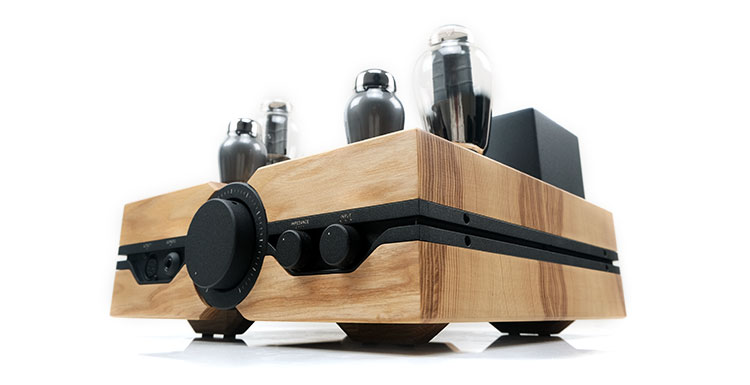
FELIKS AUDIO ENVY
The Envy/Aquarius pairing for bass texture and density with the Diana TC and the Rosson Audio Design RAD-0 was superb though at the cost of a little less staging expansiveness. You get a robust bass fundamental and a solid center image though so vocals are firm and to the fore alongside the lows and low-mids.
I would pick this pairing also with the LCD-5. The combination of punchier dense lows and a slightly more relaxed midrange compared to something like the more forward Spring 2 DAC or the mid-centric Hugo TT2 DAC makes this for a very dynamic pairing without any shoutiness.
FERRUM OOR
A few DACs have left me a bit cold with the revealing Ferrum OOR. Usually, delta-sigma neutral DACs can leave a somewhat dry and analytical tone with headphones such as the D8000 Pro and more so with the Diana TC.
Not the case here at all with the Aquarius using its NOS setting. It is still a solid-state punchy and clean sound but the texture is richer and more organic sounding than with most delta-sigma DACs I have paired with this amp thus far. Vocals also have a slightly softer edge making it a much more agreeable and smoother sounding with our tested headphones.
Just watch though the staging expansiveness is not a selling point of the OOR. It’s a good size but not as holographic as the HA-300MK2/Aquarius pairing nor will it dig as deep as the Envy.
VOLTAGE DIFFERENCES
The one caveat I still have with the Aquarius, and that seems to be a legacy feature from the Pegasus also is the slightly weaker voltage rating from its analog outputs. It just robs any pairing of a little vibrance and punchiness compared to higher Vrms rated DACs such as the Holo Audio Spring 2 and the TT2 when tested at equal volumes from our chosen amplifier.
You can up the gain a little if you so need to on solid-state amps or simply up the volume on any amplifier to partially compensate. However, it still leaves a very slightly relaxed and softer feel to the Aquarius presentation in general, especially through the mids and highs.
SELECT COMPARISONS
All impressions were completed with an Auris Audio HA-2SF amplifier, using the Final D8000 Pro and the Audeze LCD-5 headphones.
MUSICIAN AUDIO PEGASUS
$1099
The Pegasus was the company’s debut R-2R DAC launched in 2020 and reviewed by us in early 2021. It also picked up our DAC Top Gear Award for 2021.
TECHNICAL
On paper, the technical thrust of each DAC is very similar. Both use R-2R topologies with separate ladder rails for PCM and DSD and both use Musician Audio’s proprietary coded STMicroelectronics ARM Cortex-M4-based STM32F446 processor for a very high threshold of 32BIT/1536kHz and DSD1024 decoding capability.
The differences are more devil in the detail but they are still significant, nevertheless. For example, the Pegasus uses a dual 24BIT ladder network implementation of resistors matched to within 0.01% for precision resistance.
The Aquarius has double the resistor count with four 24BIT ladder networks consisting of hand-picked resistors to within a much tighter 0.005% precision resistance for a much smaller linear error rate for decoding.
Both DAC’s digital bridges are controlled by an Altera Cyclone IV though the precise nature of the crystal oscillators seems to have changed from the Pegasus FEMTO Crystal oscillation design to dual constant temperature versions in the Aquarius. This should improve frequency stability through additional protection from ambient temperature changes.
Noise and distortion performance is much better on the Aquarius with an SNR of around 5dB lower when going balanced (-128db compared to -123dB) and a THD+N of 0.001% compared to 0.002%.
There is a slight difference in the analog output ratings with the Aquarius at 3.59V for balanced XLR and 1.79V for SE and the Pegasus at SE 2.2Vrms and its balanced XLR output rated at 3.55Vrms.
As mentioned before, I always felt the Pegasus rated output was inaccurate in reality given the high impedance output rating. In our real-world testing, this proved to be the case with the Aquarius sounding much more dynamic at similar volume levels.
DESIGN
Almost but not quite a miniature doppelganger, the Pegasus design language certainly laid the groundwork for the Aquarius aesthetics and form factor. Simply add substantially more weight and make everything bigger and presto, at least on the outside, you have a flagship version.
Of course, it is not that simple but if you are thinking of upgrading from the Pegasus, the Aquarius is familiar territory. That includes the angular front plate design, the same brushed aluminum chassis, and the striking tripod rubber feet stabilizing system.
The color toning has changed for the darker versions with less of a green hue in the Aquarius and a much better labeling format for enhanced legibility of both status and button functionality.
You also get a heck of a lot more user options with NOS and Mode now split for easier management on the Aquarius and an input cycling button system that gives moves you out of the linear input cycling experience of the Pegasus.
The phase control and configurable dual I²S input I/o on the Aquarius could be a game-changer for Pegasus users who had compatibility issues with I²S streamers and transports. Aside from that digital and analog I/O are the same with options for both balanced and SE inputs.
PERFORMANCE
There are some differences on a tonal level and technical level with the technical side much more immediate. Neither are mutually exclusive though, with the technical differences of the Aquarius performance, in a way, helping to shine a light on a very pure tonal quality.
Starting with those tonal changes and here the Aquarius does seem to offer a little bit more treble extension and presence compared to the Pegasus with our tested headphones.
It is not a digital type of treble overtone from the Aquarius though switching to OS will enhance odd harmonic influences and shorten the decay ever so slightly compared to its NOS setting.
The same could be said also for the Pegasus OS versus NOS but overall, its timbre sounds lusher, mellower, and more rounded, especially through the mids.
The Aquarius, on the other hand, has the better more reference-like harmonic balance yet is still rooted in an analog quality in its coloration. Just with more definition, a tighter decay, and enhanced realism in its instrument and vocal reproduction.
On the technical side, the Aquarius goes up a few notches. The amount of air and separation is the most immediately noticeable difference throughout the presentation.
The Pegasus does very well with its vocal presence but behind the front imaging experience, the instrumental placement and separation are not quite as refined giving it a softish more diffuse presentation.
The Aquarius is more resolving, deeper, and spacious sounding with a stronger holographic staging quality as a result. Each instrument has more space with firmer imaging making them very easy to pick out.
Airy spatial cues also get a lift from the better high-frequency performance so little flutters at the very edges of the staging sound much more vibrant and dynamic in their delivery.
HOLO AUDIO SPRING 2 WILD EXTREME EDITION
Approx $2500
There are quite a few versions of the Spring DAC with the latest stock unit being version 3. This is a rare variant of the Spring 2 as modified by Wildism Audio HK and though discontinued still commands a high market price.
TECHNICAL
Both DACs internally are discrete engineered with ladder network arrays in a true-balanced implementation. The breakdown is also quite similar with both DACs offering a pure 24bit discrete R-2R design for PCM and a discrete Ladder DAC optimized architecture for DSD.
Both units are powered by O-Ring toroidal transformers with linear regulators for a stable and clean power supply. I believe Holo Audio can tweak this to the customer’s needs with a choice of 100VA O-Core Red which is copper wired like the Aquarius or a Green label option with an OCC silver wire winding.
Just to note the Wildism Extreme Edition has a 100va Pure Silver Transformer with additional Xsymphony Pure Silver Litz Wire internal wiring and a lot of upgraded Audionote Kaisei caps.
Decoding-wise, they are quite similar with a competitive DSD1024 native decoding level via dedicated 6BIT ladder networks and PCM via the main networks up to 32BIT/1536k. That drops to 24BIT/192k PCM and DSD64-DoP for its coaxial and optical inputs.
The output voltage on the Spring 2 does seem a little stronger compared to the Aquarius at 2.5Vrms for single-ended output and 5Vrms for balanced output compared to 3.59V for balanced XLR and 1.79V for SE. You might experience a slight difference in dynamic and gain levels at similar volumes when comparing these DACs.
DESIGN
The Spring 2 is bigger and heavier than the Aquarius at just over 9kg compared to 5.6kg. Height-wise there is not much difference between these two units with both offering a low-profile design.
The Holo Spring stabilizing system seems more complete to me with the traditional round pillar 4 feet configuration but at 9kg I would be expecting that. I cannot see 9kg being stable with the Aquarius tripod stabilizing feet.
The aesthetics are very different. The Spring 2 has one color option but it is an attractive mix of black and copper which extends even to a matching remote control design. The Aquarius looks good also with its aerodynamic front panel so it has its own appeal though behind that the brush aluminum panel is much more conformist.
The Spring 2 is much more information-intensive with a slightly more user-friendly control suite. Not that the Aquarius controls are hard to understand, in fact, I find them quite easy to use.
Rather, the LCD panel of the Spring 2 is immediate in terms of figuring out the status and the remote control allows you to relax and change options without having to do it manually on the unit.
The Aquarius does have an ace up its sleeve with that configurable dual I²S source selector which should provide for improved compatibility with other I²S devices compared to the single fixed I²S port of the Spring 2.
Aside from that, Spring 2 has one additional coaxial input but otherwise, the analog and digital I/O are the same on both DACs.
PERFORMANCE
A lot of the differences you will initially hear between these two will come from Spring 2’s higher voltage rating for its outputs.
What this means is the presentation is going to sound more vivid and dynamic and hits a little harder also compared to the Aquarius. The Aquarius, at similar volume levels, will come across as a little more languid in its pacing, slightly softer on the edges, and more relaxed, especially through to the mids.
The level of resolution is competitive between these two and to some extent, you can mitigate the immediacy of the presentation by carefully adjusting the volume but it will not change the overall character of the Aquarius DAC tuning which for me is the slightly warmer of the two.
The Spring 2 is on the more neutral side of analog to my ear with the more reference-like quality of the two presentations. It has a tighter dynamic bass response, more forward vocal imaging, and a stronger treble overtone in its instrumental timbre, particularly percussion energy or bite, hence that neutral overtone description.
If you are looking for reference-level realism then the Spring 2 to me is closer, though I think the additional lift from the stronger output voltage plays a significant role in its more forceful and dynamic presentation.
The Aquarius’s slightly smoother NOS presentation will gel a bit better with solid-state amplifiers such as the Ferrum OOR and headphones such as the mid-forward LCD-5 where you want a little more of that slightly relaxed mids and highs tuning.
CHORD ELECTRONICS HUGO TT2
£3995
The Hugo TT2 is a DAC, Preamp, and headphone amplifier. However, for the purposes of this comparison, we will be comparing the unique internal DAC only.
TECHNICAL
Neither of these DACs uses delta-sigma solutions, however, whereas the Aquarius used the more traditional discreet engineered R-2R implementation, Chord goes FPGA and filter based with their own in-house DAC.
The TT2 uses a Xilinx Artix 7 FPGA processor offering a complex level of filtering with no less than 86x 208MHz cores running in parallel. This allows the TT2 DAC to deliver an advanced 16FS WTA 1 filter with a ceiling of 98,304 taps.
Of course, R-2R is very different with its resistor-based ladder networks for 24BIT conversion as well ad the 6BIT ladder for DSD decoding. However, it also uses FPGA-based chipsets though more for controlling and managing its digital bridge than the actual DAC process itself.
For decoding, this is where it gets interesting. The TT2 is capable of up to DSD512 and PCM 32BIT/768kHz decoding with no MQA compatibility.
The Aquarius also has no MQA decoding compatibility but its proprietary USB stage and coding allow the unit to go up to DSD1024 and PCM 1536K if required. Is there commercial audio at this rate? Unlikely, however, the Aquarius future-proofing is potentially stronger.
Upsampling is another interesting discussion. The TT2 is modular and can be hooked up to the excellent Hugo M Scaler which will give you dual BNC upsampling from 44.1k up to 705.6kHZ, (maximum of 768kHz).
With the Aquarius, this is built-in with the option to not upsample at all via NOS. However, the rate is capped at 8X meaning 44.1kHz has an upsample ceiling of 352.8kHz. The bitrate for both DACs’ incoming signal stream can be oversampled to 32BIT.
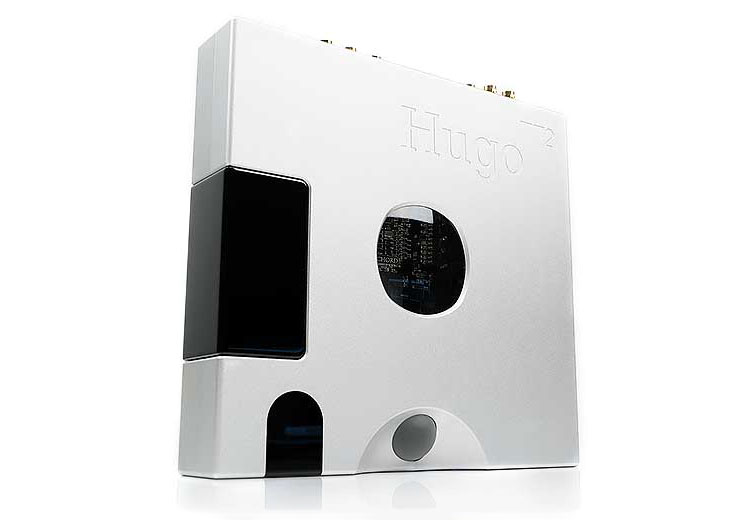
DESIGN
The Hugo TT2 is by far the smaller and more compact desktop unit weighing in at only 2.53kg compared to the Aquarius at 5.6kg.
Both are desktop but the Hugo TT2 is the more stackable of the two, recognized by the fact that the M Scaler and TToby modular units are perfectly matched form factor-wise to create a triple stack system.
Aesthetics for both is dominated by a persistent design language that permeates all of their respective company’s product lineups. The Aquarius has that angular front, brushed aluminum paneling, multiple manual button controls with strong labeling, and a tripod stabilizing foot system.
The Hugo TT2 has that chiseled minimalistic aluminum body completed with polycarbonate orbs, perspex windows galore, and a small but useable LCD panel on the front. It’s not quite as seamless as the Aquarius design but unique in its own way.
The Aquarius controls are easier to understand compared to the tiny LCD menu on the TT2. Granted, the TT2 has a lot more functionality so its options are more in-depth to cover the pre-amp and headphone output and not just the DAC.
However, combined with the orb control system it’s a higher learning curve compared to the Aquarius system. Mind you, the TT2 does have a remote control, a basic that should be with the Aquarius for its price.
The TT2 is much the busier of the two for I/O since it offers both PO and variable LO as well as dual BNC and coaxial for modular connectivity.
The TT2 also has a dual optical input as well as a variable and fixed pre-out option via 3-pin XLR balanced and dual RCA SE connectors. The Aquarius is fixed in its analog outs with balanced and SE with no preamp.
PERFORMANCE
The TT2 is the more balanced and linear of the two and ‘digitally perfect’ for resolving performances in this price tier. However, I do have a bias towards how the Aquarius delivers note texture, especially on the low-end.
In terms of depth and density, the Aquarius can dig a bit deeper, especially for bass synth or bass guitar plucks which, though perceivably a little slower paced, have more body and textural ‘grittiness’ as I call it.
The TT2 sub-bass is more neutral sounding with a stronger mid-bass punch and upper-bass presence. The tonal quality is slightly drier in the decay and has a ‘very correct’ harmonic balance if that makes sense.
The Aquarius has a more ‘separated’ feel to its bass and mids. The PRaT and weight are better but the transition from upper bass into lower mids is not quite as smooth and forward sounding with our test amplifier.
The TT2 mids are more forward and intense sounding. Detail is very much to the fore, it sounds fast, neutral in coloration, with vocals front and center. The Aquarius is roomier in the mids and with a slightly stronger treble overtone.
Again, the harmonic balance is probably more accurate from the TT2 but this can lead to the accusation it has a bit less soul or emotion. The Aquarius certainly has a bit more contrast and character and perhaps again the more interesting analog-like texture in instruments and vocals.
It’s a tough call between these two because both are superb but so different sounding. If you need precision and a stronger midrange or vocal focus with loads of micro-detail, then the TT2 is perfect. If you need more depth and power, a stronger analog sound with a ‘grittier’ textural quality then the Aquarius is a good alternative.
OUR VERDICT
I thoroughly enjoyed testing the Musician Audio Aquarius. As a pure R-2R DAC, it still retains that natural and inviting sound signature I have come to expect but as a step up from the Pegasus you get a palatable upgrade in technical capability.
I am talking about better dynamics, a bigger airier staging quality, enhanced separation and resolution, and importantly for many, a slight correction towards a more reference-like coloration in its timbral balance.
It also gels well with almost any amplifier you pair it with. It will not overcook any one aspect creating what I consider to be a very balanced and beautifully textured quality to whatever aspect of the audio signal that the amplifier chooses to emphasize.
What could I recommend being revised? Well, the voltage output could do with a minor lift compared to its direct competition and the lack of a pre-amp or remote control means some additional costs for HiFi enthusiasts. For headphone guys, the last 2 might points not be so much of an issue.
Overall, this is one classy high-end R-2R DAC and leaps and bounds more dynamic sounding than the already smooth-toned smaller sibling, the Pegasus.
MUSICIAN AUDIO AQUARIUS SPECIFICATIONS
- DSD
- DSD64-DoP On All Input,
- DSD1024 On USB & I2S Input
- PCM
- 24bits / 44.1, 48, 88.2, 96, 176.4, 192KHz On All Input
- 1536kHz On USB & I2S Input
- Sampling Mode: Non-Oversampling NOS / Oversampling OS
- Digital Inputs: USB * 1 , AES/EBU * 1 , Optical * 1 , Coaxial * 1 ,I2S* 2
- Analog Outputs: RCA * 1 , XLR * 1
- Unit Size 33*30*7.5cm
- Unit Weight 5.6KG
- Packing weight 7.35KG
